Ancient Egyptian craftsmen were highly skilled artisans whose work defined Egypt’s cultural and architectural legacy. Spanning from the Old Kingdom to the Greco-Roman era, they crafted temples, jewelry, tools, and more using materials like stone, gold, wood, and clay. Respected for their talents, many worked under royal or temple patronage and lived in specialized communities such as Deir el-Medina. Their techniques reflected religious values like Ma’at, and while most names remain unknown, their enduring creations continue to showcase the brilliance of ancient Egyptian craftsmanship.
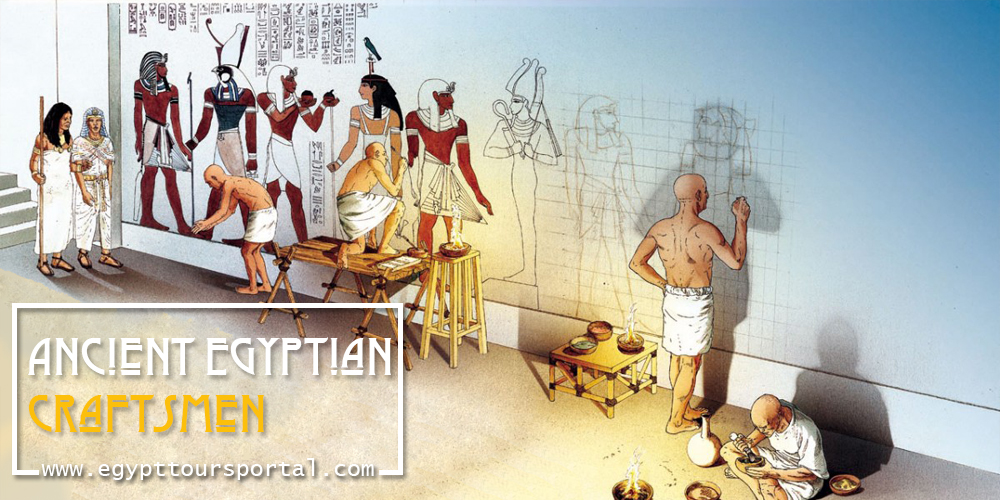
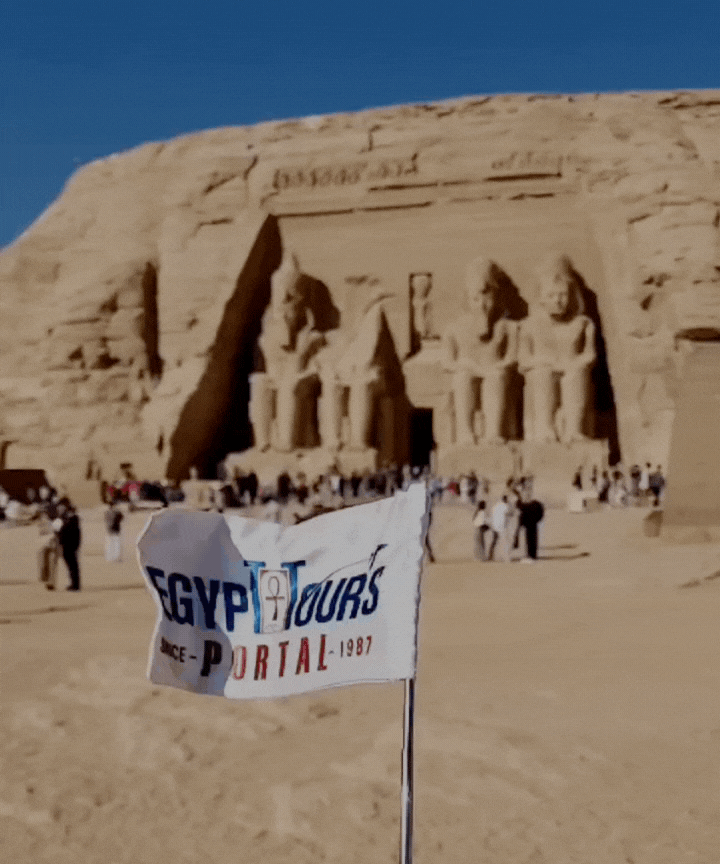
The ancient Egyptians were true original artisans, who were expert craftsmen, totally aware of their incredible skill and amazing capabilities. The ancient Egyptian craftsmen were responsible for the creation of some of the most enchanting pieces of art, which showcased the brilliance and allure of the ancient Egyptian civilization for infinite generations. These artists were considered to be more socially superior to common laborers thanks to their incredible gifts.

The ancient Egyptian craftsmen existed in Egypt since prehistoric times. The main materials used during this period were stones, clay, wood, plant fibers, ivory, animal skins, bones, and feathers. Stones such as limestone, granite, and sandstone were commonly used due to their availability and durability, and they were often chosen for creating statues, monuments, and sarcophagi.
Wood, being less abundant in Egypt, was highly valuable and imported primarily from regions like Lebanon. Clay was used extensively for ancient Egyptian pottery and construction, while plant fibers were crafted into ropes, baskets, and mats. Ivory, sourced from hippopotamus and elephants, was often used for carving fine details in small statues, jewelry, and inlay work.
Later in Egyptian history, metals were introduced into the crafting process. Gold was found in its metallic state in various locations like the Eastern Desert and Nubia, and was extensively used due to its association with the divine. Silver, which was less common in Egypt, was often imported and was frequently used as an adjunct to gold, creating precious two-tone artifacts.
Copper, tin, and iron also found their way into Egyptian craftsmanship, with copper being used in tools and weapons. Bronze, an alloy of copper and tin, marked a significant advancement, particularly during the Middle Kingdom and the New Kingdom, enabling craftsmen to create more durable tools and ancient Egyptian weapons. Iron, known as the "metal of heaven" because early iron was sourced from meteorites, became more common in the later periods and was often reserved for special ceremonial tools.
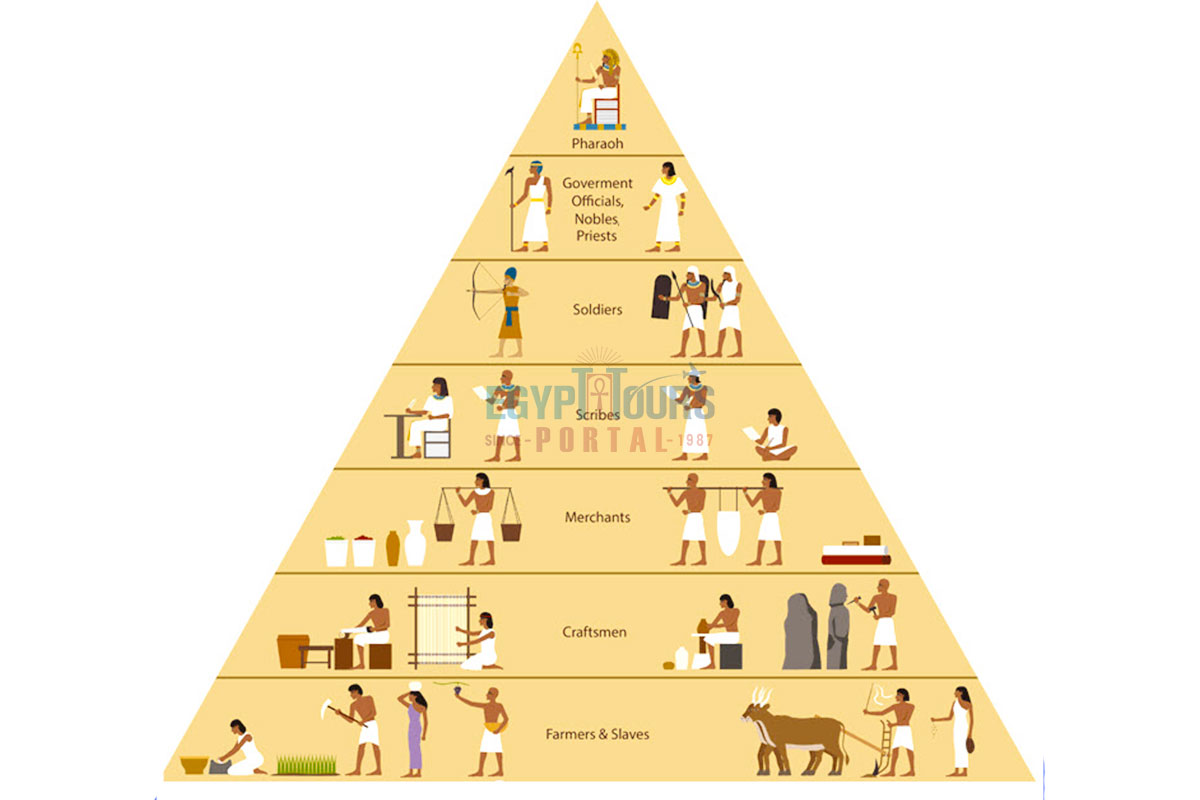
The role of craftsmen in ancient Egyptian society was pivotal but stratified according to the social hierarchy. Most of the artifacts produced by the craftsmen, including intricately carved furniture, statues, jewelry, and funerary items, were beyond the reach of the average Egyptian. Their primary clients were the pharaoh, the nobility, and the wealthy middle class, who could afford their services and appreciated the high-quality craftsmanship.
These individuals commissioned elaborate tomb goods, statues, furniture, and ritual items, which played a significant role in ensuring their comfort and prestige both in life and in the afterlife. Craftsmanship flourished in ancient Egypt partly due to the stability and economic prosperity fostered by agricultural surplus and successful trade. Trade relations with neighboring regions like Nubia, Punt, and the Levant ensured a steady flow of raw materials, which allowed craftsmen to work on a wide range of products.
The economy of ancient Egypt was bolstered by the craftsmanship industry, and many luxury items served as symbols of status and wealth. The disparity in product quality reflected the differences in social classes. The rich had beautifully carved and adorned furniture, which showcased the artisans' skills in intricate detailing, while the middle class settled for simpler, less refined products, often painted crudely. The lower class had little access to these items, often using utilitarian tools and vessels made from mud or reed.
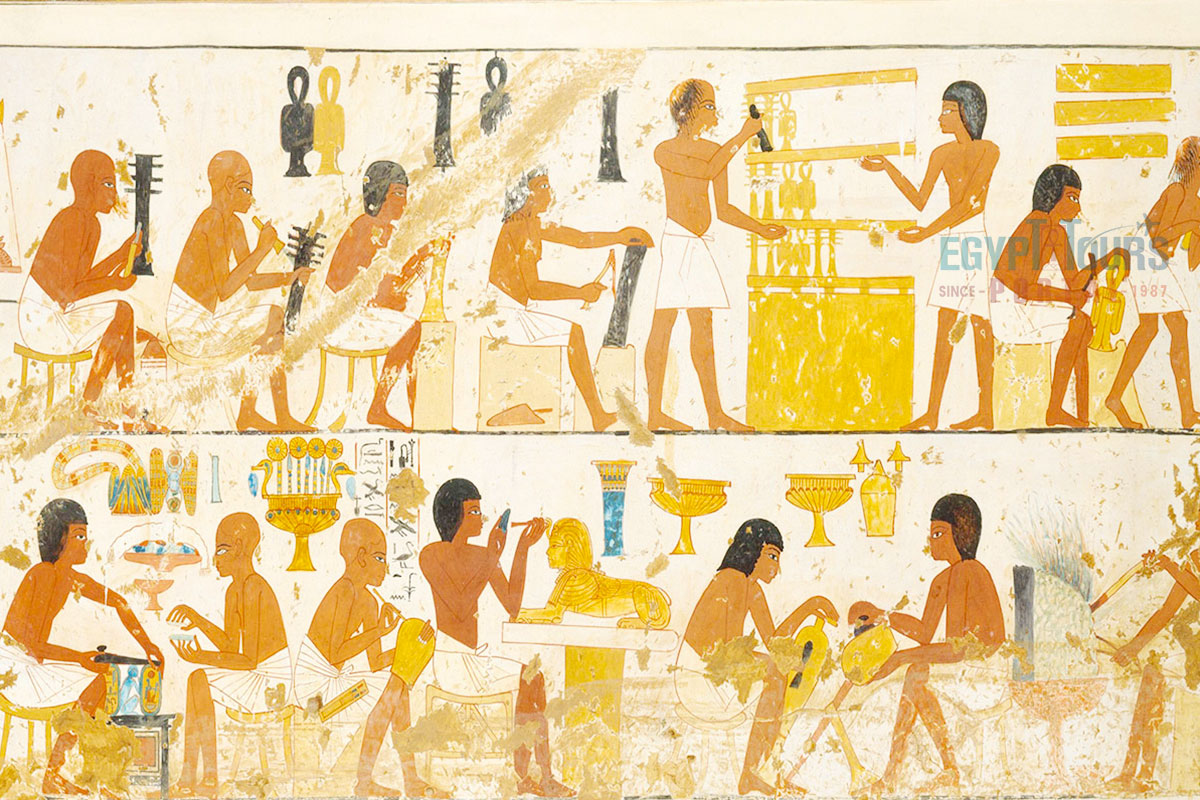
The ancient Egyptian craftsmen used an array of tools to create their products, many of which were remarkably advanced for their time. Carpenters, for instance, created a wide range of items, including roofing beams, furniture, and wooden statues. They used tools like saws, axes, chisels, adzes, bow drills, and wooden mallets. The wood, primarily imported from Lebanon due to the scarcity of native trees suitable for carpentry, was a precious commodity. Carpenters often used sycamore, acacia, and tamarisk, with cedar being particularly prized for its quality and durability.
Sculptors and stonemasons shaped and smoothed stone using hammers made of dolerite, a very hard stone that could be used to pound granite, and copper chisels, which were periodically hardened by re-tempering. They worked on materials ranging from the soft limestone of the Nile Valley to the harder granite and basalt. The colossal statues, life-sized sculptures, and intricately carved reliefs adorning temples and tombs were all products of their labor. The level of skill required to create these enduring monuments is a testament to their craftsmanship, given the limitations of their tools compared to modern equipment.
Brickmakers and potters were also integral to Egyptian society. They used the mud from the Nile River banks to produce bricks for construction and pottery for everyday use. The bricks were made by mixing Nile silt with sand and straw, placing the mixture in wooden molds, and then drying it in the sun. Potters, on the other hand, produced a wide variety of vessels using the potter's wheel. The pots were often coated with a reddish slip or decorated with geometric patterns or figures using a comb or stylus before being fired in kilns.
Bead makers and jewelers were particularly creative, producing exquisite pieces of jewelry that were both decorative and amuletic. Semi-precious stones like carnelian, turquoise, lapis lazuli, and feldspar were commonly used. The bead makers would break the stones into smaller pieces, roll them between harder stones to shape them, and then use a bow drill to bore holes through the beads. These beads were then strung together to create intricate necklaces, bracelets, and other adornments. Goldsmiths worked with gold leaf and filigree to create elaborate jewelry, sometimes inlaid with colorful stones or glass.
Leatherworkers, basket makers, and textile workers also played significant roles. Leather was used to make sandals, quivers, shields, and other items. Basket makers used palm leaves, reeds, and other plant materials to create sturdy containers for carrying goods, while textile workers spun flax into linen, which was then woven into garments. The fine linen produced in Egypt was famous for its quality and was used by all levels of society, although the finest grades were reserved for the elite.
Explore the marvelous artifacts of the ancient Egyptian civilization
Read More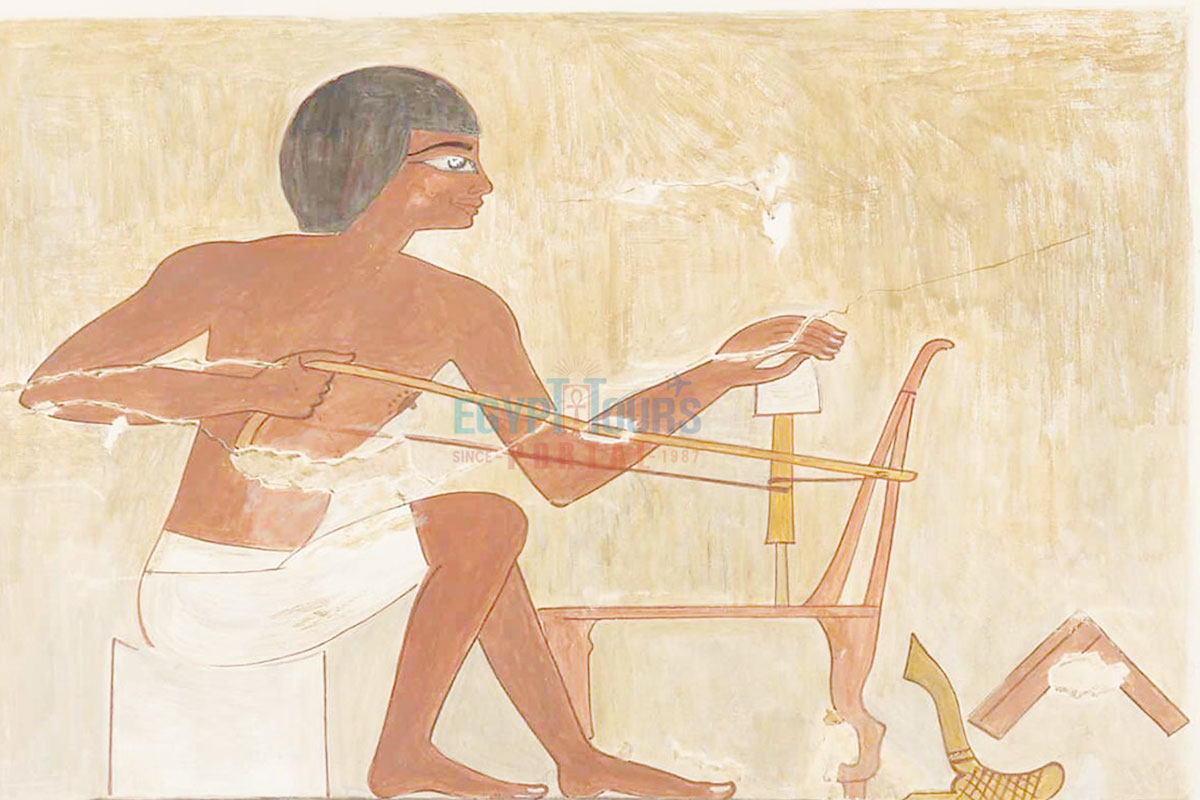
The craftsmen of ancient Egypt, whether working with stone, metal, wood, clay, or fabric, contributed significantly to the cultural richness and enduring legacy of the civilization. Their work, driven by the principles of Ma'at, was not merely functional but also symbolic, often designed to serve a religious or ceremonial purpose. The grandeur of their creations, from monumental temples to intricately fashioned jewelry, reflects their exceptional skill and dedication, as well as the important role they played in shaping the history and identity of ancient Egypt. Explore the many professions of the Ancient Egyptian Craftsmen in Ancient Egypt, which are:

Stone masonry was a cornerstone of ancient Egyptian civilization, quite literally. Stone masons were the artisans behind Egypt’s iconic monuments, including the legendary Egyptian pyramids, colossal statues, and grand temples that remain marvels of engineering and artistry. Working primarily with limestone, sandstone, and granite, these craftsmen used rudimentary yet effective tools such as copper chisels, wooden mallets, and stone hammers.
The precision required in shaping massive stone blocks for monumental structures like the Great Pyramid at Giza or the grand temples of Karnak was remarkable. Beyond physical skill, stone masons needed to have a deep understanding of geometry, measurement, and the properties of each stone to ensure that their creations would withstand the test of time. Their meticulous labor, often working in teams under master architects, helped create structures so robust and precise that many still stand today, showcasing their extraordinary skills.
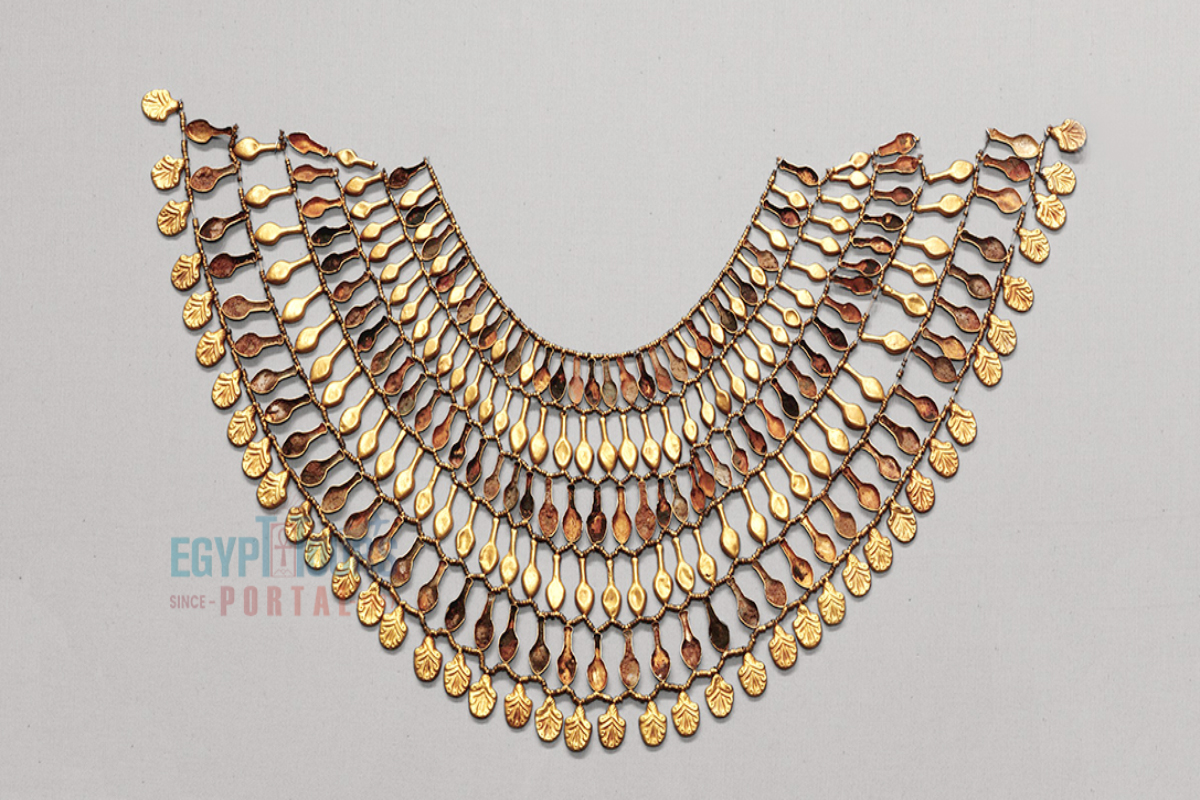
Jewelers in ancient Egypt held a prestigious position, as their creations symbolized wealth, protection, and divine favor. Jewelry was not merely decorative; it had spiritual significance and was often imbued with magical properties believed to protect the wearer. Jewelers crafted intricate pieces such as rings, bracelets, earrings, pectorals, and amulets from precious metals like gold and copper and adorned them with semi-precious stones like turquoise, carnelian, lapis lazuli, and malachite.
These craftsmen used techniques like inlaying, engraving, and cloisonné to create richly detailed designs, often depicting gods, animals, or symbols like the ankh and the Eye of Horus. Because the pharaohs and nobility prized jewelry, jewelers were highly regarded and could sometimes achieve significant status. They worked in workshops affiliated with temples or palaces, where their designs became part of the religious rituals and personal adornments of ancient Egyptian elites.

Potters were indispensable to ancient Egyptian society, as they provided the necessary vessels for daily life, ceremonial practices, and the storage of food and water. Pottery in Egypt ranged from simple utilitarian ware to finely decorated ritual pots. Potters shaped clay by hand or used a manually operated wheel to create bowls, jars, jugs, and large storage vessels. After shaping, they fired their wares in open-air kilns or ovens, often coating them with a slip (a thin layer of liquid clay) to enhance durability and appearance.
The artistry of pottery lay in both its functionality and its aesthetics, as some pottery was decorated with red ochre, geometric patterns, or painted scenes depicting nature and the daily life of ancient Egyptians. Pottery served multiple purposes in ancient Egypt, from kitchenware to containers for sacred offerings in temples, and some fine pieces were placed in tombs as grave goods, underscoring the respect and value of a potter’s work.

Weaving was an essential skill in ancient Egypt, producing textiles from linen that were used across all levels of society, from the common laborer to the elite. Linen, spun from flax plants grown along the Nile, was the primary material for clothing due to Egypt’s hot climate. The process began with spinning flax fibers into thread, which was then woven on upright looms operated by skilled weavers. The finished products ranged from simple, functional garments for everyday wear to elaborate, finely woven pieces worn by royalty and priests.
Skilled weavers produced a variety of fabrics, including sheer linens that symbolized luxury and were often adorned with decorative borders. Linen was also used for other essential items, such as sails, household items, and burial shrouds for the mummified dead. The labor-intensive process of weaving, often performed by women, made textiles a valuable commodity in ancient Egypt, one that contributed to both the economy and culture.

Artists in ancient Egypt were tasked with creating the distinctive visual style that defined ancient Egyptian art. Their work adorned the walls of temples and tombs, as well as papyrus scrolls and steles, depicting scenes that ranged from gods and pharaohs to ancient Egyptian animals and daily life. Egyptian artists adhered to strict conventions, using a highly stylized approach that included specific postures, profile views, and hierarchical proportions.
These conventions were not mere artistic preferences but were tied to ancient Egyptian religious beliefs about how the images would serve their purpose in the afterlife or communicate with the gods. Artists often worked in groups, with a master artist overseeing apprentices and journeymen who specialized in different tasks, from drawing outlines to mixing pigments and painting. Their artwork was not only decorative but also a means to convey important cultural, religious, and political messages, making artists respected members of society who preserved Egyptian ideology in visual form.
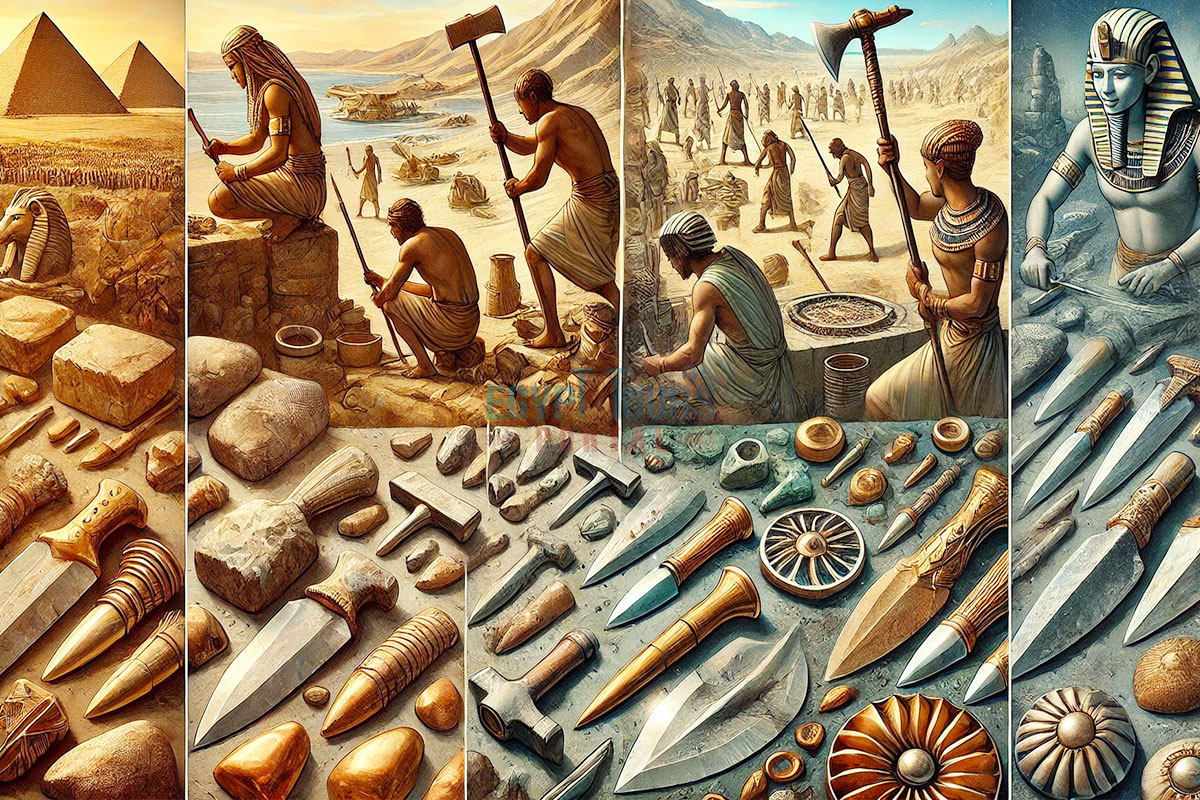
In a society where metal was scarce, blacksmiths played a critical role in crafting essential tools, weapons, and ceremonial objects. Early blacksmiths worked primarily with copper and bronze, as iron became more accessible in later periods. The blacksmith’s forge was a place of intense labor and skill, requiring knowledge of smelting and metalworking to transform raw materials into functional items.
Blacksmiths produced tools used in agriculture, construction, and even jewelry, crafting items like chisels, saws, plows, and decorative weapons. They also played a role in creating ceremonial objects used in religious rituals, adding to the symbolic weight of their work. As metalworkers, blacksmiths operated at the forefront of technological innovation, and their skills were highly valued, especially as iron smelting became more advanced, leading to tools and weapons that were stronger and more effective.

Carpenters in ancient Egypt were essential for crafting a wide range of wooden items, from practical tools and furniture to the grand ancient Egyptian chariots and wooden ancient Egyptian coffins used in burial practices. Despite the scarcity of quality wood, carpenters honed their skills with locally available materials like acacia and sycamore, and occasionally imported cedar from Lebanon for elite projects. Carpenters built boats, storage chests, beds, and intricately designed pieces that were inlaid with gold or painted with symbolic designs.
Skilled carpenters worked for the royal palace, temples, and the affluent classes, creating objects that were often decorated or painted with scenes from ancient Egyptian mythology and everyday life. Their work also extended to ceremonial items such as shrines and offering tables, which were important in religious practices. Given the complexity of their tasks and the status of their clients, carpenters were highly respected artisans whose craft was integral to Egyptian society.

Basket weaving was an age-old skill that produced indispensable items for daily life in ancient Egypt. Basket weavers used readily available materials such as reeds, palm leaves, and grasses to make baskets for carrying goods, storing food, and even for ceremonial purposes. The craft required a thorough understanding of plant materials and how they could be manipulated for durability and function.
The weavers created baskets of various shapes and sizes, from large storage containers to smaller, finely woven baskets for holding delicate items. Some baskets were simple and functional, while others were decorated or dyed, depending on their purpose and the status of the owner. In addition to everyday use, baskets were also used in religious rituals, such as offerings made to deities, showing how deeply embedded this craft was in Egyptian life.

Ancient Egyptian shipbuilders constructed vessels crucial for transportation, trade, fishing, and even military expeditions along the Nile River and the Mediterranean Sea coast. Using local acacia and imported cedar, shipbuilders crafted boats ranging from small fishing canoes to large barges that could carry heavy cargo. Shipbuilding required advanced skills, as these vessels were designed to navigate the Nile’s current while supporting large numbers of passengers or cargo.
They employed various joinery techniques, including pegged planks, lashings, and dowel joints, to build strong, reliable boats. These boats enabled the transportation of goods and people, facilitating trade with neighboring regions, and played a role in ceremonies and processions. As a result, shipbuilders were highly valued for their contributions to Egypt’s economy and mobility, making their skills essential to the kingdom’s infrastructure and trade networks.

Glassmaking was a refined and specialized craft that emerged in ancient Egypt, where glassmakers produced vibrant beads, figurines, and small decorative vessels. Glass was an expensive luxury, usually reserved for the elite and used in rituals and personal adornments. Egyptian glassmakers worked with sand and natron (sodium carbonate) and used high-temperature furnaces to melt and shape the glass, which they then tinted with minerals to achieve colors such as blue, green, and purple.
These craftsmen became known for their skill in creating translucent and opaque glass, and their colorful beads were highly valued in ancient Egyptian trade. The precision required to control temperatures and the addition of specific compounds made glassmaking one of the most complex crafts in Egypt, reflecting the technical knowledge and creative skill of the artisans who practiced it.

Bakers were fundamental to Egyptian society, as they provided staple ancient Egyptian foods—primarily bread and beer—that were daily essentials for all classes. Baking was a demanding and labor-intensive job that involved grinding grains into flour, kneading dough, and baking it in clay ovens. Bakers created various types of bread, from simple loaves to intricate shapes flavored with honey, dates, or spices, which were often used as temple offerings.
Some bread was produced as part of a ration system, especially for workers in state projects, while other loaves were crafted for the elite with more elaborate recipes. As bakers played a role in sustaining the workforce and providing religious offerings, they held a respected position within their communities, essential to both the social and religious fabric of Egyptian society.

Scribes held an elite and indispensable role in ancient Egypt, as they were among the few who could read and write the complex Egyptian script. Scribes were responsible for keeping records, writing legal documents, documenting ancient Egyptian literature, and chronicling events. Training as a scribe was a lengthy process, beginning in childhood and requiring years of study under master scribes.
They used tools like reed brushes and ink to write on papyrus, a material crafted from Nile reeds, and worked in settings ranging from temples and royal courts to construction sites. Scribes played a critical role in government administration, tax collection, religious rituals, and historical preservation. Their literacy gave them access to powerful positions, as only those with knowledge of the written language could record, interpret, and implement the laws and edicts of the kingdom.

Shoemakers in ancient Egypt crafted footwear from leather, papyrus, and other plant fibers, producing sandals that varied in design and decoration depending on the wearer’s status. Sandals were the most common form of footwear, though they were not worn by everyone, as many Egyptians walked barefoot. Elite members of society, however, wore finely crafted sandals, some of which were richly decorated with gold, beading, and elaborate designs.
Shoemakers used simple hand tools to cut, shape, and sew materials, creating footwear for everyday use as well as ceremonial occasions. Footwear was often tied to religious rituals, with ancient Egyptian priests wearing special sandals in temple ceremonies, underscoring the cultural significance of a shoemaker’s trade.

Embalming was a sacred and highly specialized profession in ancient Egypt, with embalmers responsible for preparing bodies for the afterlife through mummification. This intricate process began with the removal of internal organs, which were preserved separately, followed by the desiccation of the body using natron salts. Embalmers then wrapped the body in layers of linen, sometimes inserting amulets for protection.
The mummification process could take up to seventy days and was accompanied by complex rituals and prayers. Only certain individuals, often members of the priesthood, were permitted to perform this task, and they did so in accordance with religious guidelines that ensured the deceased would be properly prepared for eternity. The role of embalmers was one of reverence and respect, as they played a crucial role in fulfilling Egypt’s religious beliefs in the afterlife.

Pottery painters were skilled artists who decorated pottery used in everyday life as well as in religious and funerary contexts. Their work transformed simple clay vessels into beautifully adorned artifacts, often depicting animals, plants, and scenes from Egyptian mythology. Pottery painters used natural pigments to create lasting designs that could withstand the firing process, ensuring that the artwork would endure.
Their decorative work not only added beauty but also served as a form of storytelling, often depicting symbols or motifs that held significant cultural meaning. As pottery was used in both domestic and sacred settings, these artisans held a respected role in society, blending artistry with utility.
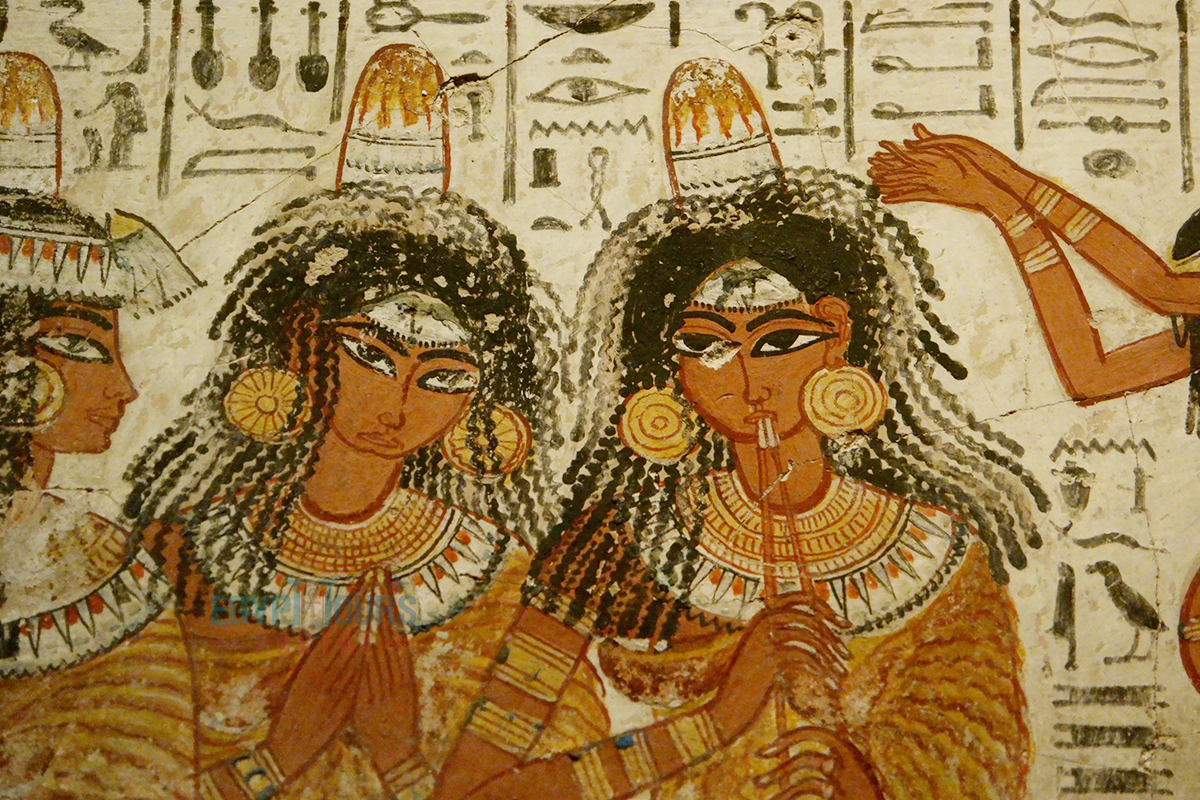
Wigs were popular in ancient Egypt, worn by both men and women to signify status and for practical reasons. Wig makers crafted wigs from human hair, wool, and sometimes plant fibers, often weaving the strands into complex braids and curls. Wigs were a practical solution to Egypt’s hot climate, as they allowed people to shave their heads for comfort and cleanliness while still presenting themselves fashionably.
The elite often wore elaborate wigs adorned with gold beads, ribbons, and ornaments, while priests and royals donned wigs in religious ceremonies to symbolize purity. Wig makers were highly skilled and created wigs for various occasions, from everyday wear to formal events, making them integral to Egypt’s cultural and social identity.
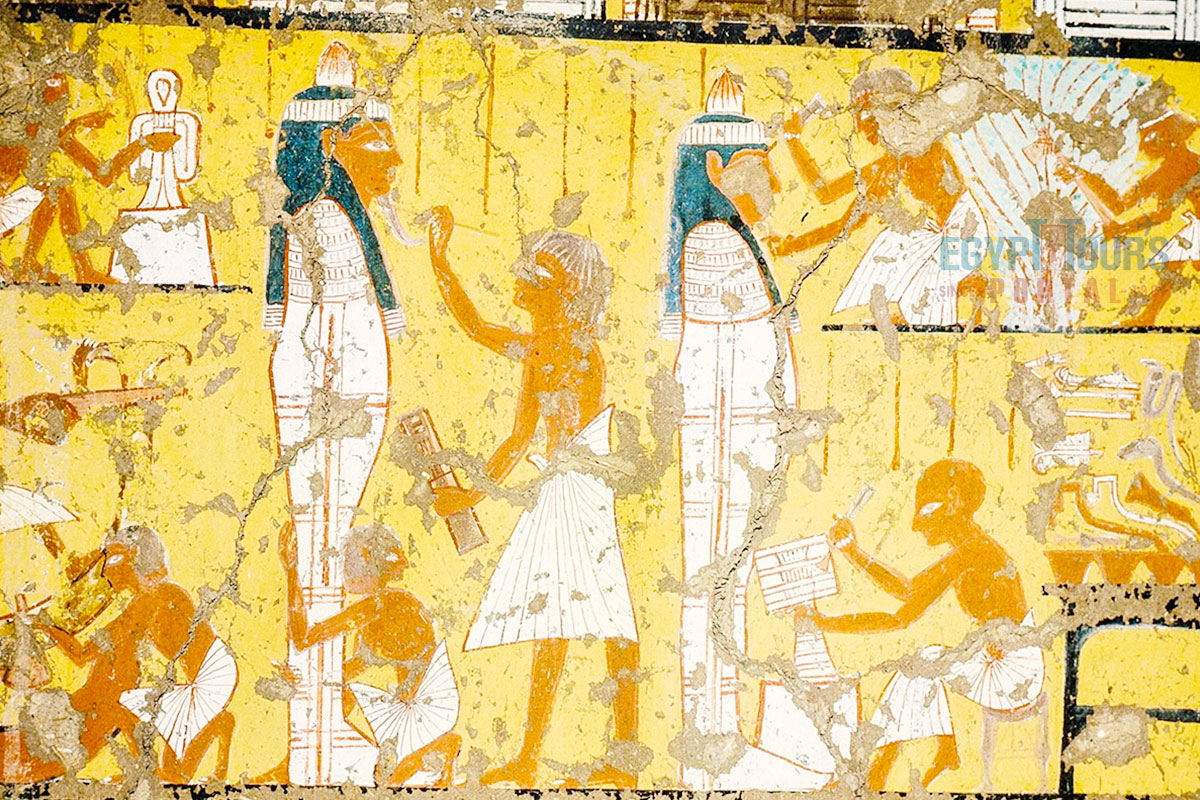
Skilled craftsmen in ancient Egypt were highly respected for their abilities, although they did not enjoy the same level of prestige as the nobles or priests. They were specialized in their respective fields, ensuring that their work was of the highest quality. Many of these craftsmen worked under royal patronage, which provided them with stable employment and access to high-quality materials. They played an essential role in creating the monuments, artifacts, and everyday items that contributed to the culture and daily life of ancient Egypt.
Explore the magnificent Professions and jobs that built a civilization
Read More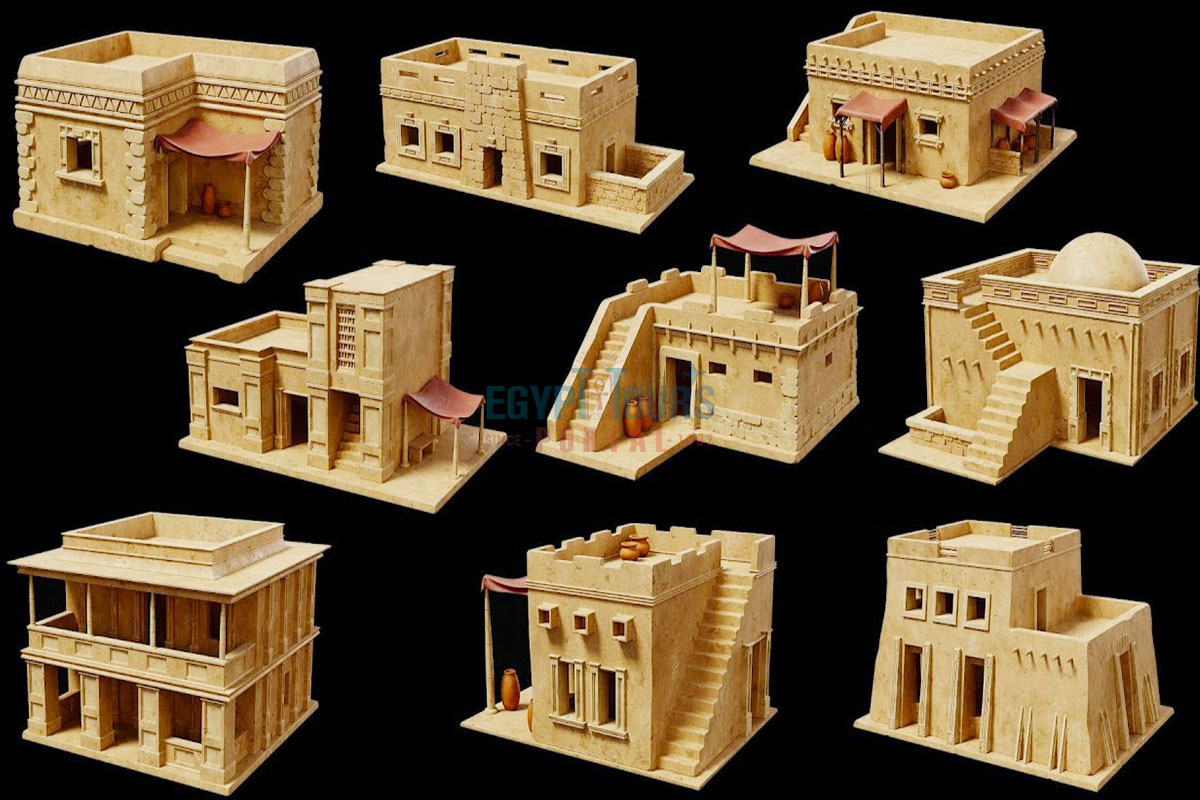
Craftsmen in ancient Egypt typically lived in modest ancient Egyptian homes, often located in villages or communities near their place of work. The craftsmen of Deir el-Medina lived in small, stone-built houses with limited space, usually consisting of a few rooms for cooking, sleeping, and working. The homes were simple but functional, reflecting the craftsmen's middle-class status. These communities were tightly knit, with a shared sense of purpose and pride in their work. The state or temple authorities often provided these homes as part of the craftsmen's compensation for their labor.
Egypt has always been known to reflect the immortal ancient beauty better than anyone, and there is no better experience than boarding a Nile river cruise on the life force and inspiration of the ancient Egyptian civilization through our Egypt Vacations to enjoy such a divine beauty of art.
Private 4 Days Cairo Tour Packages for Australian Travelers 4 days Cairo Egypt Tour ...
Tour Location: Cairo – Giza...
5 Days Cairo and Alexandria Tour Package For Australian Travelers 5 days Cairo and A...
Tour Location: Cairo/Giza/Alexandria...
6 Days Cairo, Luxor & Aswan Tour Package For Australian Travelers 6 days Cairo, ...
Tour Location: Cairo/Giza/Aswan/Luxor...
Amazing 7 Days Cairo and Hurghada Holiday for Australian Travelers 7 Days Cairo &...
Tour Location: Cairo – Giza – Hurgh...
The Ancient Egyptian Craftsmen were responsible for designing and building all aspects of Egypt. There are a number of craftsmen found in ancient Egypt such as stonemasons, carpenters, builders, sculptors, potters, blacksmiths, weavers, spinners, glass-blowers, dressmakers, scribes, and more.
Ancient Egyptian craftsmen wore simple clothing made from linen. Men usually wore a kilt-like garment known as a shendyt, while women wore long dresses. The quality of the linen varied depending on the craftsman's social status. Footwear was generally not worn while working, but sandals made from papyrus or leather were used on special occasions. In colder weather, they might wear cloaks made from thicker materials.
In their free time, ancient Egyptian craftsmen engaged in various recreational activities. They spent time with their families, attended communal gatherings, and participated in religious festivals. Music, dance, and board games like Senet were popular forms of entertainment. Craftsmen also took part in community events and religious ceremonies, which played an important role in their social lives. Hunting and fishing were also leisure activities enjoyed by those who had access to the necessary resources.
Ancient Egyptian craftsmen worshiped Ptah, the god of craftsmen and creation. Ptah was considered the patron deity of artisans, builders, and architects. He was believed to have created the world through thought and word, which resonated with the craftsmen's own creative processes. Craftsmen would often offer prayers and make small offerings to Ptah, seeking his blessings for their work. Other gods, such as Hathor, the goddess of joy, love, and beauty, and Thoth, the god of wisdom and writing, were also revered by those involved in artistic pursuits.
The diet of ancient Egyptian craftsmen consisted mainly of bread and beer, which were staples for most Egyptians. They also ate vegetables like onions, garlic, and leeks, as well as fruits such as dates, figs, and pomegranates. Meat, including fish, poultry, and occasionally beef, was consumed when available, especially during festivals or as part of their payment for work. Craftsmen who worked for the pharaoh or temples often received food rations as part of their compensation, which ensured a stable diet.
The role of craftsmen in ancient Egypt was to produce the goods and structures that supported both daily life and the spiritual needs of society. They were responsible for building temples, tombs, and monuments, as well as creating tools, household items, and luxury goods. Their work was essential for maintaining the economy, supporting the elite's lifestyle, and ensuring that the religious and cultural practices of Egypt could be carried out. Craftsmen contributed significantly to the development of Egyptian art and architecture, leaving behind a legacy that continues to be admired today.
The pyramids were primarily built by a large workforce that included both skilled craftsmen and laborers. The skilled craftsmen were responsible for the intricate stonework, carving, and finishing touches on the pyramid's interior and exterior. They worked on the statues, reliefs, and other decorative elements that adorned the pyramids. The laborers, on the other hand, handled the heavy lifting, quarrying, and transportation of massive stone blocks. Contrary to popular belief, the workers who built the pyramids were not slaves but rather paid laborers who worked in rotations and were provided with food, shelter, and medical care.
The entire country of Egypt deserve to be explored with its every heavenly detail but there are places that must be seen before any other such as the breathtaking Hurghada's red sea, The wonders of Cairo the pyramids of Giza, the great sphinx, the Egyptian Museum, Khan El Khalili Bazaar, the wonders of Luxor like Valley of the Kings, Karnak & Hatshepsut temple and the wonders of Aswan such as Abu Simbel temples, Philea temple, Unfinished obelisk and The Wonders of Alexandria like Qaitbat Citadel, Pompey's Pillar and Alexandria Library. Read more about the best places to visit in Egypt.
If you want to apply for a Visa On Arrival that lasts for 30 days then you should be one of the eligible countries, have a valid passport with at least 6 months remaining and pay 25$ USD in cash, as for the E-Visa for 30 day you should have a valid passport for at least 8 months, complete the online application, pay the e-visa fee then print the e-visa to later be presented to the airport border guard. You could also be one of the lucky ones who can obtain a free visa for 90 days. Read more about Egypt travel visa.
Egypt has a variety of delicious cuisines but we recommend “Ful & Ta’meya (Fava Beans and Falafel)”, Mulukhiya, “Koshary”, a traditional Egyptian pasta dish, and Kebab & Kofta, the Egyptian traditional meat dish.
The best time to travel to Egypt is during the winter from September to April as the climate becomes a little tropical accompanied by a magical atmosphere of warm weather with a winter breeze. You will be notified in the week of your trip if the Climate is unsafe and if any changes have been made.
You should pack everything you could ever need in a small bag so you could move easily between your destinations.
We have been creating the finest vacations for more than 20 years around the most majestic destinations in Egypt. Our staff consists of the best operators, guides and drivers who dedicate all of their time & effort to make you have the perfect vacation. All of our tours are customized by Travel, Financial & Time consultants to fit your every possible need during your vacation. It doesn't go without saying that your safety and comfort are our main priority and all of our resources will be directed to provide the finest atmosphere until you return home.
You will feel safe in Egypt as the current atmosphere of the country is quite peaceful after the government took powerful measures like restructuring the entire tourist police to include all the important and tourist attractions in Egypt. Read more about is it safe to travel to Egypt.
Wear whatever feels right and comfortable. It is advised to wear something light and comfortable footwear like a closed-toe shoe to sustain the terrain of Egypt. Put on sun block during your time in Egypt in the summer to protect yourself from the sun.
The best activity is by far boarding a Nile Cruise between Luxor and Aswan or Vise Versa. Witness the beauty of Egypt from a hot balloon or a plane and try all the delicious Egyptian cuisines and drinks plus shopping in old Cairo. Explore the allure and wonders of the red sea in the magical city resorts of Egypt like Hurghada and many more by diving and snorkeling in the marine life or Hurghada. Behold the mesmerizing western desert by a safari trip under the heavenly Egyptian skies.
There are a lot of public holidays in Egypt too many to count either religious or nation, the most important festivals are the holy month of Ramadan which ends with Eid Al Fitr, Christmas and new years eve. Read more about festivals & publich holidays in Egypt.
Egypt is considered to be one of the most liberal Islamic countries but it has become a little bit conservative in the last couple of decades so it is advised to avoid showing your chest, shoulders or legs below the knees.
Arabic is the official language and Most Egyptians, who live in the cities, speak or understand English or at least some English words or phrases. Fewer Egyptians can speak French, Italian, Spanish, and German. Professional tour guides, who work in the tourism sector, are equipped to handle visitors who cannot speak Arabic and they will speak enough English and other languages to fulfill the needs of all our clients.
The fastest way is a car, of course, a taxi. If you are in Cairo ride a white taxi to move faster or you could board the fastest way of transportation in Egypt metro if the roads are in rush hour.
The temperature in Egypt ranges from 37c to 14 c. Summer in Egypt is somehow hot but sometimes it becomes cold at night and winter is cool and mild. The average of low temperatures vary from 9.5 °C in the wintertime to 23 °C in the summertime and the average high temperatures vary from 17 °C in the wintertime to 32 °C in the summertime. The temperature is moderate all along the coasts.
It is the home of everything a traveler might be looking for from amazing historical sites dating to more than 4000 years to enchanting city resorts & beaches. You will live the vacation you deserve as Egypt has everything you could possibly imagine.









